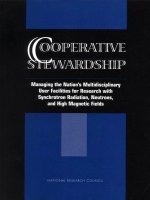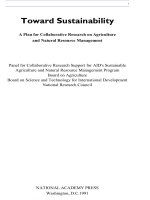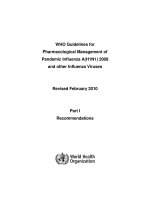Electric and Magnetic Fields FACTS pot
Bạn đang xem bản rút gọn của tài liệu. Xem và tải ngay bản đầy đủ của tài liệu tại đây (220.17 KB, 16 trang )
PREVIOUS PAGENEXT PAGE
Electric and
Magnetic Fields
FACTS
W E S T E R N A R E A P O W E R A D M I N I S T R A T I O N
NEXT PAGE
PREVIOUS PAGENEXT PAGE
1
PREVIOUS PAGENEXT PAGE
10
22
10
20
10
18
10
16
10
14
10
12
10
10
10
8
10
6
10
4
10
2
0
HZ
RadiationIonizing
Gamma
rays
X-rays
Visible
light
60 Hz and
2,450 MHz
(inside oven)
800-
900 MHz
15-30 kHz
and 50-90 Hz
60 Hz
Direct
current
Electromagnetic Spectrum
Frequency is shown in Hertz (Hz). 1 Hz = 1 cycle per
second. (Note that 10
4
means 10x10x10x10 = 10,000
Hz, etc.) kHz = kilohertz = 1000 Hz, MHz = megahertz
= million Hz.
EMF Units
Electric Fields
Usually measured in volts per meter (V/m)
For large elds the units usually used are:
1 kilovolt per meter (kV/m) =
1,000 volts per meter
Magnetic Fields
Usually measured in milliGauss (mG)
Other units sometimes used:
1 microTesla = 10 milliGauss
1 Amp/meter = 0.1257 milliGauss
PREVIOUS PAGENEXT PAGE
1
PREVIOUS PAGENEXT PAGE
E
lectric power lines are familiar to all of us. They have dif-
ferent shapes, different sized poles and varying numbers of
wires. We may not be able to guess how much power they
carry, but we all know what they do: they bring electric power to
our homes and businesses.
Many of the dramatic improvements in health, safety and
quality of life that we benet from today could not have hap-
pened without a reliable and affordable electric supply. But could
electricity be bad for our health? Electric and magnetic elds are
present wherever electricity is used. Do these elds cause cancer
or any other diseases, as some have suggested?
These important and serious questions have been investigated
thoroughly during the past three decades. Several tens of millions
of dollars have been spent worldwide.
Research on EMF still continues because no clear answers
have been found. The balance of scientic evidence to date
indicates that these elds do not cause disease. This discussion
outlines the EMF issue, summarizes the research conducted to
date, and describes what Western Area Power Administration is
doing to address concerns about EMF.
2
PREVIOUS PAGENEXT PAGE
3
PREVIOUS PAGENEXT PAGE
Electric and Magnetic Fields
EMFs are produced both naturally and as a result of human activity. The
earth has both a magnetic eld produced by currents deep inside the molten
core of the planet, and an electric eld produced by electrical activity in the
atmosphere, such as thunderstorms.
A primary characteristic of any eld is the frequency. The frequency
describes how rapidly an electric or magnetic eld oscillates, or cycles back-
ward and forward every second, and is measured in hertz. The earth’s electric
and magnetic elds do not oscillate. They are called static elds and have a
frequency of 0 Hz. Electricity produced in North America produces elds at
a frequency of 60 Hz, or 60 cycles per second, and are known as “extremely
low frequency” or “power frequency” elds. Fields at that frequency carry
very little energy and are only one small part of the electromagnetic spec-
trum that ranges from elds at a frequency of 0 Hz to frequencies in excess
of trillions of Hz. Computers, radios, televisions, cellular telephones, micro-
wave ovens, X-ray equipment and other devices we use daily operate using
frequencies within this
spectrum. The science
and effects of higher
frequency elds are
quite different from
the 60Hz elds this
brochure focuses on.
Power frequency
electric and magnetic
elds occur through hu-
man activity wherever
electricity is generated,
transmitted and used.
The Difference Between Electric and Magnetic Fields
Electric elds
Electric elds are produced by voltage. Voltage is the pressure behind
the ow of electricity. It can be compared to the pressure of water in a hose.
Voltage creates electric elds around any electrical device that is plugged
in—even if it is not operating. For instance, plugging a lamp or hair dryer
Electromagnetic Waveform
Electromagnetic
waveform
1 cycle, 1 wavelength
2
PREVIOUS PAGENEXT PAGE
3
PREVIOUS PAGENEXT PAGE
into a wall socket applies voltage to the cord, surrounding it with an elec-
tric eld. Electric elds are strongest closest to the source and with higher
voltages, but decrease rapidly within a short distance from the source. Walls,
roofs, trees and vegetation also weaken or shield electric elds. Electric elds
are measured in volts per meter.
Magnetic elds
Magnetic elds are produced by current, which is the ow of electric-
ity. Current is measured in amperes, or amps, and is similar to the volume of
water owing in a hose when the nozzle is open. Current must be owing
before magnetic elds can be produced. For example, turning on an elec-
tric appliance causes magnetic elds to surround the cord and appliance.
Magnetic elds are strongest closest to the source, and increase with higher
current ow; they also decrease with distance from the source. Unlike electric
elds, magnetic elds are not affected by walls or trees, and primarily depend
on distance from and strength of the source. Magnetic elds are commonly
measured in milliGauss (mG) and in microTeslas (µT).
Electric fields Magnetic Fields
1. Produced by voltage.
Lamp plugged in but turned off.
Voltage produces an electric field.
2. Measured in volts per meter (V/m) or in
kilovolts per meter (kV/m).
1 kV = 1000V
3. Easily shielded (weakened)
by conducting objects like trees and
buildings.
4. Reduced in strength with
increasing distance from the source.
1. Produced by current
Lamp plugged in and turned on.
Current now produces a magnetic field, also.
2. Measured in gauss (G) or tesla (T)
1 milligauss (mG) = 0.1 microtesla
(µT) milli
(m) = 1 thousandth
micro (µ) = 1 millionth.
3. Not easily shielded (weakened) by most
materials.
4. Reduced in strength with increasing distance
from the source.
4
PREVIOUS PAGENEXT PAGE
5
PREVIOUS PAGENEXT PAGE
Exposure
Standards and Guidelines
It is not known if any EMF levels are unsafe. Some nongovernmental
organizations have set advisory limits as a precautionary measure based
on the knowledge that high levels of elds (more than 1,000 times the EMF
found in typical environments) may induce currents in cells or stimulate
nerves. The International Commission on Non-Ionizing Radiation Protection
has established a continuous magnetic eld exposure limit of 0.833 Gauss
(833 mG) and a continuous electric eld exposure limit of 4.2 kV/m for mem-
bers of the general public. The American Council of Governmental Industrial
Hygienists publishes Threshold Limit Values for various physical agents. The
TLV for occupational exposure to 60 Hz magnetic elds has been set as 10 G
(10,000 mG) and 25 kV/m for electric elds. Several states have set guidelines
for electric and magnetic eld levels that must be met for newly constructed
transmission lines. These levels at the edge of right-of-way are about 2 kV/m
Typical 60 Hz magnetic eld levels
from some common home appliances
Magnetic eld 6 Inches
from appliance (mG)
Magnetic eld
2 feet away (mG)
Electric shaver
100 -
Vacuum cleaner
300 10
Electric oven
9 -
Dishwasher
20 4
Microwave oven
200 10
Hair dryer
300 -
Computers
14 2
Fluorescent lights
40 2
Faxogram machines
6 -
Copy machines
90 7
Garbage disposals
80 2
4
PREVIOUS PAGENEXT PAGE
5
PREVIOUS PAGENEXT PAGE
for electric elds and 200 mG for magnetic elds. In most cases, the values
are maximum elds that existing lines produce at maximum load-carrying
conditions. Researchers have used 2 mG in several studies as the threshold
magnetic eld value to differentiate between average exposed and more
exposed persons. This is based on average elds found in homes, and not for
any scientic reason.
Natural sources
The earth’s elds are static, or 0 Hz frequency. The earth’s magnetic eld
which everyone is constantly exposed to is about 500 mG. The earth’s electric
eld is about 100 V/m, but thunderstorms can temporarily increase the eld
in a given location to several thousand V/m.
Sources within the home
In the home, in addition to the earth’s natural elds, there are power
frequency elds. All electric appliances produce electric and magnetic elds
with a 60 Hz frequency. Fields are greatest closest to the surface of the cord
and appliance and drop rapidly in just a short distance. The average house-
hold background 60 Hz magnetic eld is about 1 to 2 mG. The average back-
ground 60 Hz electric eld is 1 to 20 V/m.
Typical field level
6 inches
2 feet
40mG
2mG
6
PREVIOUS PAGENEXT PAGE
7
PREVIOUS PAGENEXT PAGE
Overhead lines
All overhead lines produce elds. The elds are usually the highest
directly under the lines and fall rapidly with distance to the sides of the line.
Actual eld strengths will, of course, vary depending on the height of the
conductors from the point of measurement.
Typical 60 Hz electric and magnetic eld levels from overhead power lines
Line
voltage
Centerline
Approx.
edge of
right of way
100 feet 200 feet 300 feet
115 kV
Electric
eld kV/m
Magnetic
eld mG
1.0
30
0.5
6.5
0.07
1.7
0.01
0.4
0.003
0.2
230 kV
Electric
eld kV/m
Magnetic
eld mG
2.0
57.5
1.5
19.5
0.3
7.1
0.05
1.8
0.01
0.8
500 kV
Electric
eld kV/m
Magnetic
eld mG
7.0
86.7
3.0
29.4
1.0
12.6
0.3
3.2
0.1
1.4
Electric elds from power lines are relatively stable because voltage does not change. Magnetic elds uctuate greatly
as current changes in response to changing load. The magnetic elds above are calculated for 321 power lines for
1990 mean loads.
6
PREVIOUS PAGENEXT PAGE
7
PREVIOUS PAGENEXT PAGE
Underground lines
Underground lines can produce higher magnetic elds directly above
them than an overhead line would produce at ground level, because the
buried cable is closer to the ground surface. Magnetic elds fall away more
rapidly than from overhead lines because of some shielding from the earth.
There are no external electric elds produced because of the shielding from
the earth. Underground lines are more expensive to install and more difcult
and expensive to repair than overhead lines. Because of heat generated at
higher voltages, most underground cables are lower voltage distribution lines,
such as those that provide power to residential neighborhoods.
Substations
EMFs are produced within electric substations, but due to the spacing of
electrical equipment measured eld strengths are low outside the fence line.
Fields close by a substation are mainly produced by the entering power lines.
Other eld sources
We are surrounded daily with elds from many other sources having
frequencies different than 60 Hz. These sources include emissions from com-
puters, radio and television towers, cellular telephones, weather and air trafc
control radar, military and commercial communications systems, household
and industrial remote control devices, intrusion detection equipment and
many others. Fields from 60 Hz electrical systems are a very small sliver of
the total natural and man-made electromagnetic spectrum environment we
live in.
Stray voltages
Sometimes, cattle and dairy farmers express concern about a herd’s be-
havior, weight loss or decreased milk production and blame EMFs from near-
by transmission or distribution lines. Investigation of the situation normally
shows the cause to be stray voltages. Stray voltages are from deteriorating
wiring, or defective, or improperly wired or grounded, equipment. While
standing on damp earth or other conductive ground, the animal receives a
small electric shock when contacting parts of milking equipment, electrically
heated or pumped watering facilities or other electric equipment around the
farm. Electric companies usually offer stray voltage diagnosis services.
8
PREVIOUS PAGENEXT PAGE
9
PREVIOUS PAGENEXT PAGE
Research into Potential Health Effects
With any issue that involves human health, it is important that scientic
research be conducted to nd out about possible causes, effects and solutions.
Three main types of research are being conducted to determine if EMFs could
be related to disease.
Epidemiology
Epidemiology is the study of patterns of disease in populations. Epidemi-
ology looks for any statistical link between exposure to EMF and disease in
human populations. Concerns about EMFs were rst raised in an epidemio-
logical study when two scientists suggested that levels of elds encountered
in some homes might lead to childhood cancer. Since then, other diseases in-
cluding adult cancers, heart disease, Alzheimer’s disease and depression have
been examined to determine if there could be a link between them and EMFs.
Epidemiology can only look at populations and observe statistical as-
sociations. It cannot eliminate the many other possible factors that could
determine the development of diseases and, therefore, cannot prove whether
a particular disease is caused by EMFs.
About 20 epidemiological studies have been performed looking at the
possible link between magnetic elds and childhood leukemia. Several other
studies have looked at other diseases in relationship to magnetic elds for the
general population and in the workplace. Some studies have found a weak
association with magnetic elds, and others have not. Where there is associa-
tion suggested, it is usually very near the statistical threshold of signicance.
When these studies are repeated, the results are generally not reproduced.
Replication of results is a basic test of scientic validity. Research continues
to look at magnetic elds until a more certain conclusion can be reached.
Very little evidence exists to conrm that electric elds have any as-
sociation with childhood cancer, and some research suggests specically they
do not.
8
PREVIOUS PAGENEXT PAGE
9
PREVIOUS PAGENEXT PAGE
Theoretical
Theoretical research looks for a possible mechanism that can demonstrate
how the elds could react with living systems. A variety of theories have
been put forth over the years but no such mechanism has been found that
would operate at the levels of elds seen around homes or near power lines.
Biological
The test of any proposed theory or proposed health risk is biological
research in the laboratory to observe the effects of EMFs on cells, tissues and
organisms. Scientists look for effects that can be successfully replicated in
different laboratories for proof that a cause-and-effect relationship exists.
Hundreds of EMF-related biological research projects have been conducted.
In 30 years of research, there have been no such reproducible results. The
evidence from the laboratory is that low EMF levels of the kind experienced
by the public do not cause the diseases that have been claimed.
Our use of electricity has increased exponentially over the past 100 years,
likely resulting in greater daily exposures to power frequency EMFs. In gen-
eral, it has been found that rates of cancer, considering improved diagnostic
methods, have remained level or decreased somewhat. While many other
variables are unaccounted for, these two observations would suggest that
exposure to normal 60 Hz eld levels is not a major human health issue.
10
PREVIOUS PAGENEXT PAGE
11
PREVIOUS PAGENEXT PAGE
EMF Research References
Research related to possible adverse health effects of EMFs has been in
progress for more than 30 years. It is not reasonable to list or summarize
the results of past and ongoing research in this document because of the
great amount of information. Work conducted by the National Institute of
Environmental Health Sciences/Department of Energy EMF Research and
Public Information Dissemination Program provides EMF research informa-
tion and references. The publication Electric and Magnetic Fields Associated
with the Use of Electric Power, Questions and Answers prepared under the
NIEHS/DOE EMF RAPID program, specically Chapter 6, National and Inter-
national EMF Reviews, and Chapter 7, References, supplies a comprehensive
summary and listing of research. The document is available online at http:
//www.niehs.nih.gov/emfrapid. Another NIEHS report is Questions and
Answers, EMF in the Workplace.
Additional EMF information resources are available from:
California Department of Health Services
California EMF Program
/>Medical College of Wisconsin, Electromagnetic Fields and Human Health
/>Environmental Health Information Service
/>Microwave News
World Health Organization
10
PREVIOUS PAGENEXT PAGE
11
PREVIOUS PAGENEXT PAGE
Limiting Exposure to EMF
Research has not determined if exposure to EMFs could be a health risk.
Scientists are studying long-term exposure to low elds, exposure to certain
transient waves and other kinds of EMFs. You may prefer to take low- and
no-cost steps to limit your exposure to strong elds as a way to reduce po-
tential risk. Some scientists call this “prudent avoidance.” For instance, you
might:
■ Move your motor-driven electric clocks or other electrical devices
away from your bed.
■ Stand away from an operating microwave oven or other appliances
that use a lot of electricity.
■ Sit away from the TV and at least an arm’s length away from the com-
puter screen and processing unit.
■ Decide to use a safety razor instead of an electric one.
While steps like these may lower your exposure to 60 Hz elds, it is far
more difcult to limit exposure to EMFs in the rest of the vast electromag-
netic spectrum. It is virtually impossible to reduce exposure to broadcast fre-
quencies and radar, for instance. Some scientists have recommended limiting
cell phone use as a prudent avoidance measure, however.
12
PREVIOUS PAGENEXT PAGE
PREVIOUS PAGENEXT PAGE
Western’s EMF Position
Western recognizes the public concern over the possible health effects of
electric and magnetic elds. While primary exposure to EMFs for most people
is in the home and at work, Western realizes that some people have concerns
about EMFs created by our transmission facilities.
In the past 30 years, scientists have studied the relationship, if any, of
EMF to human, plant and animal health. Congress mandated in 1992 that
Federal agencies and the scientic community research and conduct a com-
prehensive review of potential EMF effects on health. These studies concluded
in 1997 that there is only “weak” evidence that magnetic elds increase the
risk of cancer and other human disease.
Scientic research continues on a wide range of questions relating to
EMF exposure, and some of this work has hinted at possible health risks.
A comprehensive EMF health risk assessment by the World Health Organi-
zation is under way, and will likely inuence decision making and further
research. The research is expected to continue for several more years. Until
conclusive or more specic research results are obtained, Western will con-
tinue to take prudent actions regarding EMFs.
Western will continue to:
■ Provide balanced and accurate information to employees, customers
and the public. EMF measurements will continue to be made upon
request.
■ Support and participate in scientic research on EMF and monitor
results of research activities by utility, government and private groups.
■ Pursue and implement alternative design and siting approaches for
new and upgraded transmission facilities to reduce the public exposure
to EMFs, particularly when the siting of the facilities may occur in
populated areas.
Western is committed to providing a safe, healthy environment for our
employees and safe, reliable and economic electric energy to our customer
and communities.
12
PREVIOUS PAGENEXT PAGE
PREVIOUS PAGENEXT PAGE
For more information about Western or EMF, call or write your nearest
Western ofce:
Corporate Services Ofce
Mailing address: P.O. Box 281213, Lakewood, CO 80228-8213
E-mail:
Phone: 720-962-7000
Fax: 720-962-7200
CRSP Management Center
Mailing address: P.O. Box 11606, Salt Lake City, UT 84147-0606
Phone: 801-524-5493
Fax: 970-240-6295
Desert Southwest Region
Mailing address: P.O. Box 6457, Phoenix, AZ 85005-6457
Phone: 602-605-2525
Fax: 602-605-2630
Rocky Mountain Region
Mailing address: P.O. Box 3700, Loveland, CO 80539-3003
Phone: 970-461-7200
Fax: 970-461-7213
Sierra Nevada Region
Mailing address: 114 Parkshore Drive, Folsom, CA 95630-4710
Phone: 916-353-4416
Fax: 916-985-1934
Upper Great Plains Region
Mailing address: P.O. Box 35800, Billings, MT 59107-5800
Phone: 406-247-7405
Fax: 406-247-7408
P.O. Box 281213
Lakewood, CO 80228-8213
8-05
T
O
F
E
N
E
R
G
Y
D
E
P
A
R
T
M
E
N
U
E
N
I
T
E
D
S
T
A
T
S
O
F
A
E
R
I
C
A
M
PREVIOUS PAGE









